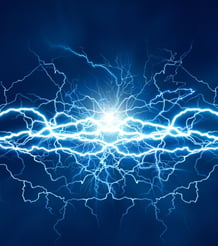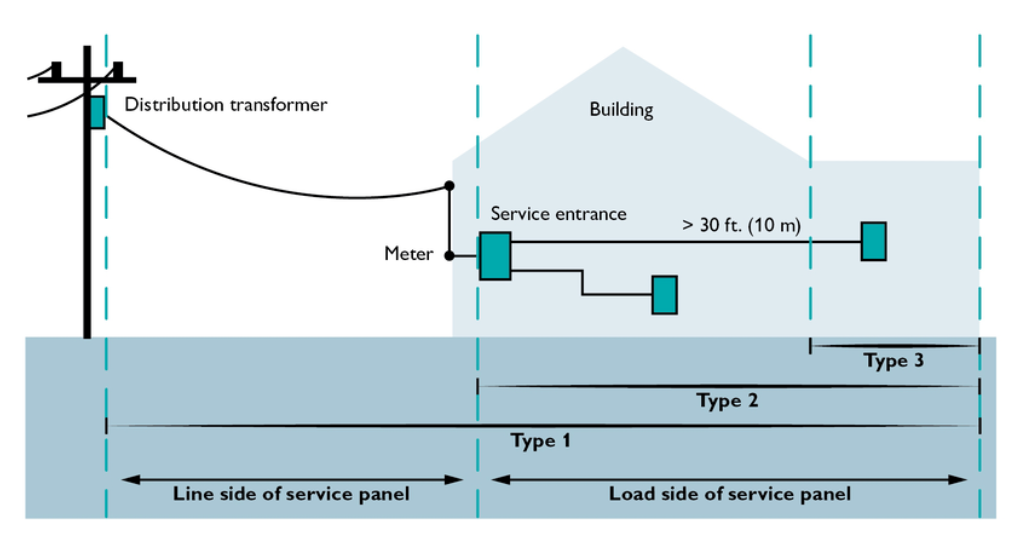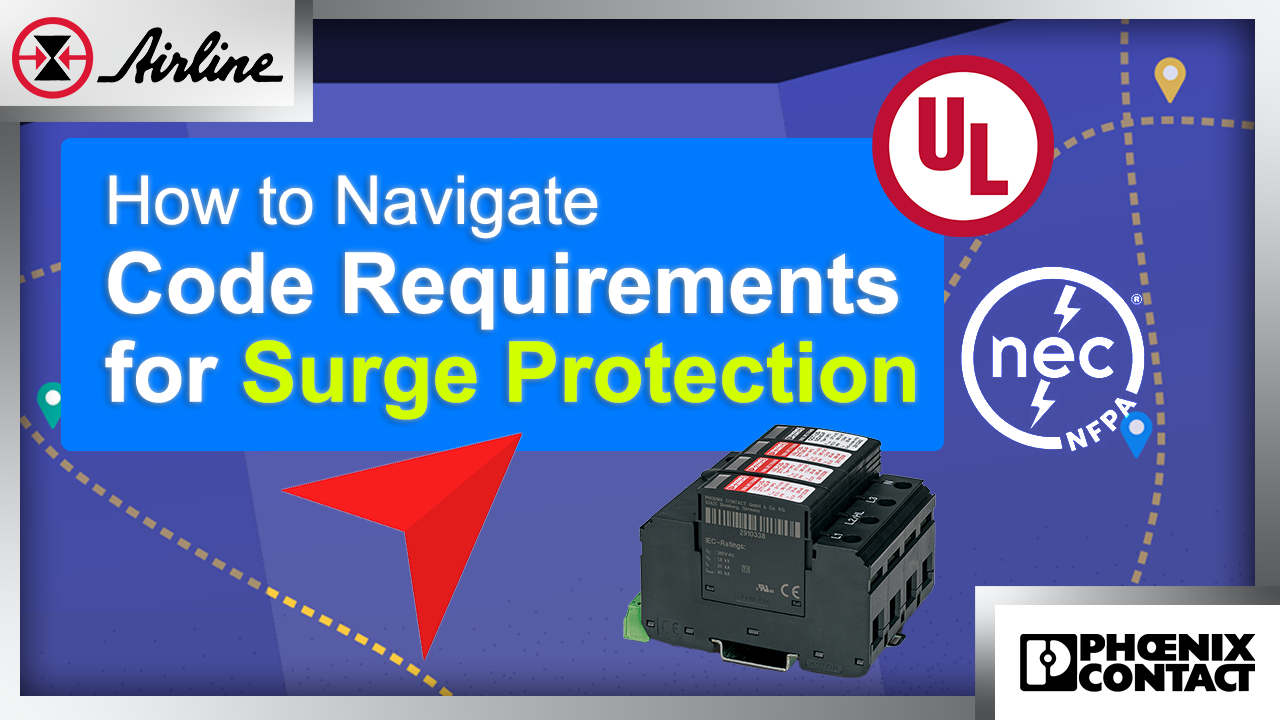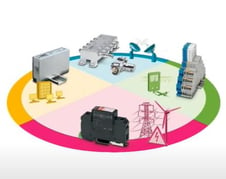Safety is at the forefront of today's system designs, including electrical safety for electrical boxes and control cabinets. That's why surge protection devices are a new requirement for many electrical standards and codes. A growing number of states are incorporating these requirements into their regulations every year, making compliance mandatory. In today’s blog post, I'll go over what these standards are, (including NFPA 79 standards), what they mean in regards to surge protection, and how you can apply them in your applications.
 Jump To Section:
Jump To Section:
Electrical Standards and Codes Intro
Complying With Surge Protection Requirements
On-Demand Webinar, How to Navigate NFPA 79 and NEC Code Requirements for Surge Protection
Elite Support
Tools & Resources
What is Surge Protection?
Surge protection requires a surge protection device (also called SPD, or surge arrestor) to protect electrical devices from voltage spikes in alternating current (AC) circuits. A voltage spike (or surge) is a short, transient event that can reach over 1,000 volts. Large voltage spikes can burn through wiring insulation and cause fires, but even modest spikes can destroy electronic devices, and cause damages to equipment that are plugged in at the time of the surge.
Surge protection devices (SPDs) are categorized into three main types (see image below):
| Type 1 SPDs | May be installed downstream of a transformer and upstream of the main overcurrent protection of the power system. May also be installed in Type 2 or 3 locations as well. |
| Type 2 SPDs |
Must be installed downstream of the main overcurrent protection of the power system. May also be installed in Type 3 locations. |
| Type 3 SPDs |
Must be installed a minimum of 30ft (~10m) downstream of the main overcurrent protection of the power system. |

An Introduction to Electrical Standards and Codes
We’ll be referencing these “nesting dolls” of codes and standards throughout this blog post:

National Electric Code (NEC) - Installation Regulation
You'll see this widespread code applied often, ranging from inspections in single-family housing to machine factory floors. This code regulates every electoral installation, so when inspectors at a local or county level come into your facility, they will look for national electrical code compliance and ensure that the electrical devices are installed in accordance.
![]()
NFPA 79 Electrical Standard - Risk Mitigation, Machinery Directive
This code is the machinery derivative of the NEC standards, addressing specifically whether industrial electrical components will cause any damages to property or injuries to personnel. It addresses topics like operating conditions, disconnects, protection from electrical hazards, control circuits, and even wire color codes. UL 508A - Standard for Control Cabinets
UL 508A - Standard for Control Cabinets
Underwriters Laboratories, or UL, is an independent, not-for-profit company that tests electric products for safety. UL 508A is a prevalent standard for control cabinets in many machinery applications within the US.
UL 1449- Standard for Surge Protective Devices
The UL 1449 is a standard specifically for surge arrestors. If a surge protector doesn't have a UL listing, it most likely will not comply with this standard.
Requirements for Surge Protective Devices (SPDs)
NEC Requirements
The NEC is revised every three years, and the first mention of installing SPDs on some of these applications happened in 2014. Yet, in 2017, the code required many more applications, including industrial machinery, to incorporate SPDs. So, as we move forward, these codes are building and growing from each other.
For example, suppose you’re in a state where NEC 2020 is starting to be enforced (see image below). You would be required to add surge arrestors to your home or system if it’s being rechecked. If you’ve added an addition to your house that requires more electricity, you may have a requirement to add an SPD to the application. NEC is a continually evolving standard, and states adopt NEC at different rates.
NFPA 79 Requirements
NFPA revises its NFPA 79 standard every three to five years. These standards change because the NFPA receives a lot of feedback about electrical risks from the field. They first create loose codes based on what they see as the source and the entry points of hazards. As they study the results, they start getting stricter and stricter with these codes and receive more feedback as the field adopts them.
For example, installation requirements for SPDs were first described in the 2015 edition. However, there were no requirements to use SPDs, at that time. This update is now (as of when writing this article) in NFPA 79, 2018, in article 7.8.1, requiring SPDs for equipment protection.
How to Comply with Current SPD Requirements
To align with current SPD requirements, you must follow these three general steps:
1. Define the system configuration and voltage level powering your application. This is needed to define what size surge protection device you’ll need to comply with new regulations. If you have the voltage configuration defined, you’re on an excellent path to compliance with this code.
2. Determine the correct UL Listed SPD to use. For help, refer to our Surge Protection Quick Reference Guide.
3. Install the listed SPD into the application in accordance with the device's specifications for your application.
A good rule of thumb is to apply a circle of protection to your system. The circle of protection determines if paths in or around your systems need to be protected. The goal is to consider all of the potential entrance points for surges. While it's common to watch the system’s mains, there could be other paths for risks to arise. Therefore, it’s essential to use the circle of protection concept to truly safeguard applications from surges and other risks.
Although the circle of protection and use of SPDs will differ for each application, there are some device configurations commonly used to comply with current standards. Learn more about these components and configurations by watching our FREE On-Demand Webinar, How to Navigate NFPA 79 and NEC Code Requirements for Surge Protection.
Get Elite Surge Protection Support
Airline Hydraulics is an Elite Distributor for Phoenix Contact, manufacturer of UL Listed products specifically used to meet NFPA 79 regulations and meet the most commonly used voltage in the United States. Contact our product experts and shop Phoenix Contact surge protection components on Airline’s website with access to real-time availability from Airline or factory stock, pricing documentation, accessory items, and more.
Don’t forget to subscribe to our blog!
If you have a question or comment about this post, please leave it in the comments below!
Tools & Resources
On-Demand Webinar, How to Navigate NFPA 79 and NEC Code Requirements for Surge Protection
Airline Website – Purchase Surge Protection
State by state NEC Adoption Info
Phoenix Contact NFPA 79 Landing Page
Phoenix NFPA 79 Products (VAL-US)






%20copy.png)





Leave Comment